
Cornelis van Lit
Welcome to my website. I develop digital methods and data analysis for historical research. My personal expertise is in applying this to Arabic texts from the Islamic world. You can browse through all my publications below, or visit my thematic page on my project on digital manuscript studies here and on my current project on Ibn ʿArabī's Reshaping of the Muslim Imagination here.
Type
Topic
Sort by
Among Digitized Manuscripts
Philology, Codicology, Paleography in a Digital World
Working with manuscripts has become a digital affair. But, are there downsides to digital photos? And how can you take advantage of the incredible computing power you have literally at your fingertips? Cornelis van Lit explains in detail what happens when manuscript studies meets digital humanities. In Among Digitized Manuscripts you will learn why it is important to include a note on the photo quality in your codicological description, how to draw, collect, and publish glyphs of paleographic interest, what standards (such as TEI and IIIF) to abide by when transcribing a text, how to write custom software for image recognition, and much more. The leading principle is that learning a little about computers will already be of great benefit.
Leiden: Brill, 2020. ISBN: 9789004415218. Pages: xii, 333 pp.
Digital Humanities and Religions in Asia
An Introduction
In pre-modern religions in the geographical context of Asia we encounter unique scripts, number systems, calendars, and naming conventions. These can make Western-built technologies – even tools specifically developed for digital humanities – an ill fit to our needs. The present volume explores this struggle and the limitations and potential opportunities of applying a digital humanities approach to pre-modern Asian religions. The authors cover Buddhism, Christianity, Daoism, Islam, Jainism, Judaism and Shintoism with chapters categorized according to their focus on: 1) temples, 2) manuscripts, 3) texts, and 4) social media. Thus, the volume guides readers through specific methodologies and practical examples while also providing a critical reflection on the state of the field, pushing the interface between digital humanities and pre-modern Asian religions into new territory.
Berlin: De Gruyter, 2023. ISBN: 9783110747256. Pages: 332 pp.
Verlost van onzin
Autobiografie van al-Ghazali
De bevlogen middeleeuwse denker Ghazali is nog altijd een bron van inspiratie voor miljoenen moslims. Ook in de westerse literatuur duikt de naam van Ghazali geregeld op. Daar wordt hij eensgezind aangewezen als een strenge dogmaticus. Wie was deze Ghazali en waar komt zijn reputatie vandaan? Kan het echt zo zijn dat hij het einde van het vrije denken in de islam inluidde? In Verlost van onzin komt Ghazali zelf aan het woord. Deze toegankelijke vertaling van Ghazali’s autobiografie, voorzien van uitgebreide context en interpretatie, daagt de lezer uit om zelf te oordelen.
Amsterdam: Boom, 2021. ISBN: 9789024438297. Pages: 224 pp.
The World of Image in Islamic Philosophy
Ibn Sīna, Suhrawardī, Shahrazūrī and Beyond
One of the most controversial issues that divided Islamic philosophers and theologians during the Middle Ages was whether human beings would have a spiritual or bodily existence after death. The idea of a world of image was conceived as a solution, suggesting that there exists a world of non-physical (imagined) bodies, beyond our earthly existence. This world may be reached in sleep, in meditation or after death. From the embryonic conception by Ibn Sina, to the radical rethinking by Suhrawardi and Shahrazuri into a sophisticated system, L. W. C. van Lit unravels the history of this idea. Using a distant reading approach for measuring the transmission, he further shows how the idea remained relevant for Muslim thinkers through the centuries, up until today.
Edinburgh: Edinburgh University Press, 2017. ISBN: 9781474415859. Pages: 288 pp.
Quran for Text-Fabric
Deep textual research using a text-as-a-graph model
This repository contains text and annotations of the Quran. The corpus is modeled as a text-fabric data resource which is optimized for processing the text as data. This makes it easier to do all kinds of research on the text.
Text-Fabric is several things: a browser for ancient text corpora, a Python3 package for processing ancient corpora, A corpus of ancient texts and linguistic annotations represents a large body of knowledge. Text-Fabric makes that knowledge accessible to non-programmers by means of built-in a search interface that runs in your browser. From there the step to program your own analytics is not so big anymore. You can export your results to Excel and work with them from there. And if that is not enough, you can call the Text-Fabric API from your Python programs. This works really well in Jupyter notebooks.
Quran for Text-Fabric, L.W. Cornelis van Lit and Dirk Roorda, 2019, Licensed as CC-BY 4.0.
The Digital Orientalist
Practical examples and theoretical reflections on the do's and don'ts of using digital tools in Humanities research.
The Digital Orientalist is an online magazine with an editorial team of eight, affiliated with The American Oriental Society.
The Digital Orientalist, 2013-2020.
Commentary and Commentary Tradition
The Basic Terms for Understanding Islamic Intellectual History
The term ‘commentary’ is usually understood as either exegesis or advocacy. Often this does not seem to do justice to the extant commentaries from the Islamic Middle Ages. Building on Shahab Ahmed’s interpretation of Islam, I put in place a theoretical framework for understanding commentaries. This framework requires us to take the graphical form of the text as our base unit, and from here I propose analytical definitions of ‘commentary’ and related terms. These are based on textual relations capturing different kinds of verbal agreement between two texts. I argue that verbal agreements are an important part of Islamic text-writing, to connect one’s own thought with that of the wider discourse. A commentary is, as I shall conclude, a text with ‘structural textual correspondence’. Sets of texts, most notably a ‘restricted commentary tradition’, are also defined and they are tools to establish the right context in which to study these commentaries.
Mélanges de l'Institut Dominicain d'Études Orientales (MIDÉO), Cairo: Ifao, vol. 32, 2017, pp. 3-26.
Getting Ready for the CV Revolution
This keynote reflects on why computer vision is a particularly attractive technology to invest in. The technology itself is developed to such an advanced degree that it is easy to use and promises good results. The digitization projects of the last few decades have ensured that there is a wealth of data available exactly for this kind of application. Methodologically it will find a ready home within frameworks such as new philology and distant reading. And lastly, it will speak to a quickly growing group of people whose research agenda is not dominated by digital humanities but who nonetheless wish (and are able) to implement digital methods. Considering the trajectory of these four different aspects, it seems highly likely that computer vision will see wide adoption across the humanities, especially in fields which rely heavily on manuscripts and documents. This is because currently their digital surrogates are photos – exactly the kind of data that computer vision knows what to do with. Notes on how to get ready and be an early adopter are given throughout the presentation.
An Ottoman Commentary Tradition on Ghazālī’s Tahāfut al-falāsifa
Preliminary Observations
Ghazālī’s “The incoherence of the philosophers” spurred a counter-commentary by Ibn Rushd, as is well known. Up to ten texts from Ottoman scholars also purport to be commentaries on the Tahāfut, constituting a commentary tradition that has been neglected by scholars. The first two commentators, Khojazāda (d. 1488) and ʿAlāʾ al-Dīn Ṭūsī (d. 1482), are not line-by-line exegetes of Ghazālī, but rather update the discussions that Ghazālī broached to the level of knowledge available to them. Khojazāda was favored by the Ottomans, but ʿAlāʾ al-Dīn’s content, methodology and argumentation style proves to be just as, if not more, interesting for us.
Oriens, Leiden: Brill, vol. 43, pp. 368-413.
The Commentary Tradition on Suhrawardī
Suhrawardī (d. 1191) has been hailed as a crucial thinker in the history of philosophy in the Islamic world, as first suggested by Henry Corbin. However, the actual influ- ence of Suhrawardī on thinkers after him has mostly been assumed rather than estab- lished. In the centuries after Suhrawardī, the late-medieval and early-modern period of Islamic intellectual history, the writing of commentaries was a popular phenome- non. This did not automatically mean that the commentator was in favor of the ideas of the original author. Therefore, tracing a commentary tradition is a measurement that gives us a fairly good insight, both positive and negative, into the reception of a particular intellectual. In this article I contribute to a more precise understanding of Suhrawardī’s legacy, by putting together a list of all known commentaries, of which I have identified fifty-eight in total, with at least thirty-one of these extant.
Philosophy East & West, Honolulu: University of Hawaii Press, 68:1, 2018, pp. 539-563.
Suhrawardī, Ibn ʿArabī, and the World of Image
One term different meanings
After summarizing the idea associated with the term ‘world of image’ within the discourse of Suhrawardī and his commentators, I discuss relevant terminology and argumentation in Ibn ʿArabī’s two major texts, al-Futūḥāt al-makkiyya and Fuṣūṣ al-ḥikam. This will show that to argue for a Suhrawardian influence requires interpreting certain passages very favorably, while ignoring the philosophical context in which Ibn ʿArabī makes these remarks. I then do the same for Ibn ʿArabī’s most important early commentators, additionally pointing out that this issue was still further developed from commentator to commentator. I end with examples of how the two discourses perceived each other, namely, as largely in agreement on certain issues yet fundamentally different.
Journal of the Muhyiddin Ibn ʿArabī Society, vol. 62, 2017, pp. 21-48.
Among Digitized Manuscripts Europe Tour
Leiden, Hamburg, Berlin, Jyväskylä, Fribourg, and London
To discuss my book I went around Europe to talk to leading experts in universities and libraries in december 2019. It was a great experience which I recorded in a series of videos.
Ottoman Commentaries on Islamic Philosophy
Ottoman History Podcast
Commentaries are a common, even a nearly ineluctable, part of the textual landscape of the early modern Ottoman Empire. Especially when it came to philosophy, commentaries were perhaps the main venue of discussions. An earlier generation of scholars believed these commentaries to be derivative but we now see them as a major piece in the development of the philosophical tradition in the Middle East. In this podcast, we speak with L.W.C (Eric) van Lit about how to approach these commentaries and their effect on the intellectual life of the Ottoman Empire in the fifteenth and sixteenth century.
Ghiyāth al-Dīn Dashtakī on the world of image (ʿālam al-mithāl)
The place of his Ishrāq Hayākil al-nūr in the commentary tradition on Suhrawardī
Dawānī (d. 1502) wrote a commentary on Suhrawardī's Hayākil al-nūr. In it, the notion of the world of image is only mentioned a few times, but is never properly discussed, perhaps due to the fact that Suhrawardī himself does not mention anything of the like in his epistle. Dawāni's commentary was itself subject of another commentary, called Ishrāq Hayākil al-nūr, by Ghiyāth al-Dīn Dashtakī (d. 1542). We find embedded in this text an independent, twenty pages long epistle, dedicated to the subject of the world of image. In this paper, we shall examine this epistle in some detail. I shall start by explaining where the epistle is located in the super-commentary, and how it is embedded. Then I shall point out its source and discuss exactly how Dashtakī’s text depends on other texts. This is mainly achieved through a detailed analysis of one passage of the epistle. Afterwards, I shall discuss those parts of the text that are not to be found in the main source. Special attention will be given to those parts that seem to have flown from Dashtakī’s own pen. Finally, we will put this epistle in the context of his corpus of writings, and establish to what extent he himself seems to be committed to the idea of a world of image.
Ishrâq: Islamic philosophy yearbook, Moscow: Vostochnaya Literatura Publishers, vol. 4, 2014, pp. 116-136.
Python in digital humanities research
Talk Python To Me
You've often heard me talk about Python as a superpower. It can amplify whatever you're interested in or what you have specialized in for your career. This episode is an amazing example of this. You'll meet Cornelis van Lit. He is a scholar of medieval Islamic philosophy and woks at Utrecht University in the Netherlands. What he is doing with Python is pretty amazing. Even if you aren't interested in digital humanities and that type of research, the example set by Cornelis is a blueprint for bringing Python into your world and for those around you. I think you'll enjoy this conversion.
Orientalist Keyboard Layouts
Transliterating and typing Arabic in a transliterated way
Keyboard layouts for macOS and Windows for typing in Arabic script and Arabic transliteration in Latin script. These layouts will make it easier for non-native speakers of Arabic to type out text as letters are assigned to keys in a more intuitive manner, as though you are transliterating. The transliteration layout will make typing šṭrānġē characters used for scholarly transliteration of Arabic a flawless and painless job - system wide, meaning that this does not only work within Microsoft Word but works anywhere on your computer within any software.
Orientalist Keyboard Layouts, L.W. Cornelis van Lit, 2014, Licensed as CC-BY 4.0.
The measurement of the circle in Naṣīr al-Dīn al-Ṭūsī’s Revision of the ‘middle books’ (Taḥrīr al- mutawassiṭāt)
The mathematical treatises known as Taḥrīr al-mutawassiṭāt, “Revision of the Middle books”, are a collection of Greek and Arabic treatises which were re-edited by Naṣīr al-Dīn al-Ṭūsī. This paper explores the nature of the editorial work Ṭūsī did, showing that it is not a simple rendering of the original text but that it involves major revisions and in fact original additions. For the first time, a collated version of Ṭūsī’s revision on the treatise on the measurement of the circle (by Archimedes) is provided. A translation of the Arabic text is put side by side with a rendition of the treatise as it was circulated before Ṭūsī’s time. An in-depth analysis of the text elucidates the nature of Ṭūsī’s contributions to the text. This article also provides modest corrections to earlier studies by W. R. Knorr and P. Luckey.
Tarikh-e Elm, 10, 2012, pp.1-42.
Seals from the Staatsbibliothek zu Berlin
Training data for automated detection
This repository is a first step towards the compilation of an Islamic seals database comprising the following components: - digital photos of pages with seals, retraceable to the original artifact. - cut-outs of seals. - scripts for aggregating these resources. - scripts for automatically identifying similar/same seals. This repository took the collection at the StaBi as a first case. As such, this repository can be used as a data set for training purposes.
Seals from the Staatsbibliothek zu Berlin, L.W. Cornelis van Lit, 2020, Licensed as CC-BY 4.0.
Codex Analyzer
For mass-processing digitized manuscripts
Automated analysis of the flap of Islamic manuscripts, built in Python with OpenCV, PyPDF2, Pillow, and NumPy. Please note that the script has been delivered 'as is' and should be tailored to your own use case.
Codex Analyzer, L.W. Cornelis van Lit, 2020, Licensed as CC BY-NC-SA.
Behind the Looking Glass
Starting out with Digital Humanities
Tutorial video on beginning with digital humanities; the principles and learning strategies you need to know to incorporate digital methods in your work. This was produced as part of the NISIS Autumn School 'Islamic and Middle Eastern Studies in the Digital Age'.
The Digital Orientalist
Scholarship is Becoming Bigger and Better
Over the last few years, I have been writing about how computer technology can be implemented in day-to-day scholarly activities on my weblog, www.digitalorientalist.com. That name, The Digital Orientalist, was chosen to reflect the very question I wished to explore: can computer technology of today and tomorrow be fruitfully put to use in a field like Islamic Studies which is borne out of old- fashioned philological work? Is there such a species as a “digital orientalist,” or is that a contradiction in terms? I soon realized that the question is actually of a slightly different order. It is not a question of possibility, but rather of necessity. The shift from print to digital comes with a whole slew of ramifications that either have already taken place or are in the process of coming about. Students and scholars operate in a drastically different way than ten to twenty years ago. But at the same time, there is an astonishing lack of reflection on this shift and just as little technical know-how among said students and scholars. In this essay I shall describe some of those drastically different ways in which scholarly activities are executed, especially those that have in one way or the other to do with libraries. My description is largely based on my own experience, and this piece may therefore be best read as a user case. I think libraries and librarians could (and already do) play a vital role in integrating computer technology into day-to-day academic activities, in a flourishing and sustainable way. I hope that this piece inspires a continued dialogue between librarians and patrons on such issues.
MELA Notes, Middle East Librarians Association, vol. 88, 2015, pp. 1-8.
Osama bin Laden als popidool
Terwijl de massamedia een oneindige stroom aan populaire cultuur de huiskamer inslingeren, bevindt zich op korte afstand een compleet andere wereld. De wereld van martelaars en aanslagen op internet.
ZemZem, 2008, vol. 4:2, pp. 32-38.
A Digital Revival of Oriental Studies
“The Digital Orientalist” is the name of an online magazine focused on using computer technology in research related to one of the domains of the Humanities that can be or has traditionally been called “Oriental.” Thus, we mean “Oriental” in the sense of how learned societies use it such as the American Oriental Society, or the Deutsche Morgenländische Gesellschaft, or in the sense of institutions such as Institut national des langues et civilisations orientales in Paris or the School of Oriental and African Studies in London. While the background history of the magazine will explain how the name has a rather innocent origin, we realize that the name is problematic. More than once, people have complained about it, considering it outdated at best, arrogant at worst. We do not mean it to be like that but rather, we see similar problems and solutions related to computer technology, among these various fields of Humanities that come together under the banner of “oriental”. In this article, we explain more fully our raison d’être.
ILCEA: Revue de l’Institut des langues et cultures d'Europe, Amérique, Afrique, Asie et Australie, Grenoble: Université Grenoble Alpes, 39, 2020, pp. 1-14. Available OA: http://journals.openedition.org/ilcea/10327
Constructing a World of its Own
a Translation of ‘The Epistle on the Establishment of the Imaginable, Apparitional World
Even though Quṭb al-Dīn Shīrāzī (d. 1310) may have written the more influential commentary on Suhrawardī’s (d. 1191) Ḥikmat al-ishrāq, it was Shams al-Dīn Shahrazūrī (d. ≥1288) who authored the more original one. Hossein Ziai made a significant contribution towards this appreciation by publishing his edition of Shahrazūrī’s Sharḥ Ḥikmat al-ishrāq, thereby complementing the earlier publication of Quṭb al-Dīn’s commentary. In the same spirit, we offer here a translation of Shahrazūrī’s chapter on the world of image (ʿālam al-mithāl) from his Rasāʾil al-shajara al-ilāhiyya, whose importance was first pointed out by Hossein Ziai. With this translation we aim to follow the example of John Walbridge’s accessible translation of Quṭb al-Dīn Shīrāzī’s “epistle of the ʿAllāma al-Shīrāzī ascertaining the reality of the world of image.
Illuminationist Texts and Textual Studies: Essays in Memory of Hossein Ziai, ed. by A. Gheissari, J. Walbridge, and A. Alwishah, Leiden: Brill, 2018, pp. 160-178.
Islam Felsefesi ve Bilginin dolayımi
El Yazmaları Üzerinden Yüz Yüze Sohbet
Diğer tüm yüksek medeniyetler gibi İslam medeniyetinin de hıfzedil- miş bilgiye duyulan tümüyle sahici ama taklide dayalı hürmete rağ- men aslında bir yazılı kültür medeniyeti olduğu” sıkça söylenegel- miştir. Aynı şekilde İslam medeniyeti modernlik öncesinin en kitabi kültürlerinden biri olarak adlandırılır. Bu şekilde düşünen yalnızca çağdaş araştırma- cılar değildir; istinsahını bitirdiği bir Kur’an nüshasının sonuna, 11. yüzyılda, “Yaşam solar, yazı kalır.” diye yazmıştır, hat üstadı Ebû Amr Osman El-Verrâk.
Sabah Ülkesi, vol. 52, pp. 78-81.
Een dodelijke typefout
Ibn Taymiyya over interreligieuze dialoog
Grote religies zijn, voor zover ik weet zonder uitzondering, ten dele aan- gewezen op schrift. Dan bedoel ik niet eens een ‘heilige schrift’ die een bepaalde openbaring vastlegt, maar er zijn zoveel en zulke ingewikkelde dingen te vertellen dat het mond op mond doorgeven niet meer te doen is. De verzameling van al die teksten noemen we ‘traditie’. Dat is dus een andere definitie van traditie dan die we doorgaans gebruiken, namelijk die van ‘een verouderd gebruik’. Bij een verouderd gebruik doe je iets, maar je weet niet precies waarom; zo doe je dat nu eenmaal. Bij de tradi- tie van religies gaat het er juist om dat je wel weet waarom je iets doet, je zoekt het namelijk op in die berg met teksten die een religie heeft voort- gebracht. Binnen die traditie is er een ander belangrijk begrip, namelijk dat van ‘canon’. Dat is als het ware de kern van de traditie, het centrum, met andere teksten meer aan de rand. Wat in het centrum is, is welbe- kend en wordt alom erkend en gerespecteerd; wat aan de rand van de traditie is, daar kan zelfs veel verzet of onenigheid over zijn.
Wie is er Bang voor Religie, ed. J. Wagemakers and L. van Liere, Almere: Parthenon, 2019, pp. 276-281.
Said the Prophet of good
by Joel Blecher
This is not a book about a prophet called Saïd. Instead, it is an eloquently written, skillfully researched study of the mechanics of writing commentaries on hadith collections...
Al-ʿUṣūr al-Wusṭā, 2019, pp. 319-325.
La fin de tout chose
by Christian Jambet
Jambet’s book consists of a translation of a 17th-century philosophical treatise, running about a 100 pages, together with a 200 page introduction, providing an intellectual and religious (not so much historical) context...
Mélanges d'institute dominicain d'études orientales, vol. 34, 2019, pp. 384-387.
The Digital Humanities and Islamic & Middle East Studies
ed. by Elias Muhanna
Under review is an edited collection on how to perform computer-supported research in Islamic Studies. Such computing technology can be used for “digitization, publication, and interpretation” (p. 4), and in the last two decades this has been done on such a scale that we can no longer deny the transformative effect it has on our work; the fields of Islamic Studies and Middle East Studies have entered the Digital Age....
Journal of the American Oriental Society, vol. 137.4, 2017, pp. 855-858.
Islamic Intellectual History in the Seventeenth Century
by K. El- Rouayheb
This book is a groundbreaking study on post-classical Islamic philosophy which I expect to have a lasting impact on the field. Whereas others have used an author or a book as a focus to break into the vast subject of post-classical Islamic philosophy, El-Rouayheb limits himself to a time period and a region. He sets up his base camp in the seventeenth century, an interesting choice as this is right before what A History of Muslim Philosophy calls ‘The Dark Age.’....
Global Intellectual History, London: Routledge, 1, 2016.
An Anthology of Philosophy in Persia: From the School of Illumination to Philosophical Mysticism
ed. by S.H. Nasr and M. Aminrazavi
This book is the fourth volume of a massive anthology, dealing roughly with the period from the 13th to the 16th century. This late medieval period is receiving more and more attention lately, and so this anthology is timely. While previously Nasr and Aminrazavi had stated they would able to complete their project in four volumes, they now write that a fifth part will follow, mostly to cover areas that had to be left out in this volume due to space limitations (p. 1). They limit their fourth volume to around 500 pages, just like the previous volumes....
Ilahiyat Studies, Bursa: Ilahiyat Fakültesi Uludağ Üniversitesi, vol. 4:2, pp. 267–271.
Philosophy in Early Safavid Iran: Najm al-Dīn Maḥmūd al- Nayrīzī and His Writings
by R. Pourjavady
The book under review here is an admirable piece of scholarship that will be of help to many scholars and students interested in late medieval Islamic intellectual history. In this review, I will discuss the book in such a way that prospective readers may make economical use of the book. The book can be approached from two angles, as indicated by the two-part title: “Philosophy in Early Safavid Iran” on the one hand, and “Najm al-Dīn Maḥmūd al-Nayrīzī and His Writings” on the other hand. Thus, the book actually is comprised of one part discussing late 15th century philosophical activity in Shiraz and another part detailing the life and works of one of these philosophers, al- Nayrīzī...
Ilahiyat Studies, Bursa: Ilahiyat Fakültesi Uludağ Üniversitesi, vol. 3:2, pp. 294-296.
Chance and Determinism in Avicenna and Averroes
by C. Belo
In Chance and Determinism, Belo presents some pertinent topics from Avicenna’s and Averroes’ philosophy with great clarity and shrewdness. She states in her introduction that ‘‘the three themes of chance, matter and providence are treated with the aim of achieving a comprehensive overview of their metaphysics and physics with reference to the issue of determinism’’, and this is indeed exactly what the book offers...
Al-Masaq, London: Routledge, vol. 24:2, pp. 219-220.
Al-Ghazālī’s Philosophical Theology
by F. Griffel
As we near the nine-hundredth anniversary of the death of Abū Ḥāmid al-Ghazālī, his writings remain as popular as ever. This is not surprising, not only because of these texts’ historical importance but also because aspects of them still feel relevant to today’s reader, whether Muslim or non-Muslim. The vast amount of scholarly output on him attests to al-Ghazālī’s preeminence in Islamic intellectual history. To this large field, Frank Griffel has contributed his new book Al-Ghazālī’s Philo- sophical Theology. In it, Griffel has synthesized his long-standing and extensive work on al-Ghazālī into one book that covers a variety of topics...
Philosophy East and West, Honolulu: University of Hawaii Press, vol. 61:3, pp. 564-567.
Report on the International Symposium on Khojazāda
After a successful symposium on Mullā Fanārī in 2009, the Theol- ogy Faculty of Uludağ University and the Bursa Metropolitan Munici- pality organized a symposium on the Ottoman intellectual Khojazāda (d. 893/1488) from 22 to 24 October 2010...
Ilahiyat Studies, Bursa: Ilahiyat Fakültesi Uludağ Üniversitesi, 2010, vol. 1:2, pp. 278-281.
Maimonides’ Dalālat al-hāʾirīn
Inleiding en Vertaling
Moses Maimonides is zonder twijfel een van de belangrijkste joodse geleerden aller tijden. Zijn Commentaar op de Misjna en zijn Misjneh Tora behoren tot de klassieke lite- ratuur van de joodse traditie die tot op de dag van vandaag bestudeerd worden. De gids voor de verdoolden, waarvan wij hier een frag- ment presenteren, genoot echter ook grote bekendheid buiten joodse kringen.
25 Eeuwen Theologie, ed. by M. Poorthuis and L. ten Dam, Amsterdam: Boom, 2017, pp. 254-259.
Al-Ghazālī’s al-Maqṣad al-asnā en
Inleiding en Vertaling
De invloedrijkste moslim na de profeet Mohammed is Abū Ḥāmid Al-Ghazali, zo wordt gezegd. Hij was niet alleen in zijn eigen tijd de toonaangevendste theoloog, hij bleef ook na zijn dood veelgelezen, tot op de dag van vandaag. Zijn oeuvre is breed en rijk, in verschillende onderwerpen toonaangevend.
25 Eeuwen Theologie, ed. by M. Poorthuis and L. ten Dam, Amsterdam: Boom, 2017, pp. 304-308.
Imam al-Gazali's Incoherence of the Philosophers
تهافت الفلاسفة للإمام الغزالي
ضمن إطار مبادراتها البحثية والفكرية وإتاحة مساحات من التواصل الأكاديمي والثقافي، عقدت مؤسسة طابة مساء أمس ندوة فكرية تحت عنوان: «تهافت الفلاسفة» للإمام الغزالي وحضوره في البحث الفلسفي عند علماء الأشاعرة والماتريدية، للدكتور إرِك فان لِت، المحاضر بقسم الدراسات الدينية بجامعة ييل الأمريكية والباحث الزائر بمعهد الدراسات الشرقية للآباء الدومنيكان.
Tabah Foundation, Cairo.
ندوة: " الفلسفة الإسلامية في مرحلة ما بعد الكلاسيكية "
البحث عن مرجعية ودور أبي حامد الغزالي
استضاف مركز دال للأبحاث والإنتاج الإعلامي التابع لمؤمنون بلا حدود يوم السبت الموافق 16 يناير 2016م الدكتور إريك فان ليت، عضو مركز ماكميلان لدراسات الشرق الأوسط بجامعة ييل بالولايات المتحدة الأمريكية، وذلك في ندوة عملية بعنوان: " الفلسفة الإسلامية في مرحلة ما بعد الكلاسيكية: البحث عن مرجعية ودور أبي حامدالغزالي"، وذلك في تمام السادسة مساءًا بمقر الأبحاث بجاردن سيتى. وأدارت الباحثة بريهان خالد تفاصيلها.وذلك في حضور عدد من الباحثين والدارسين والمهتمين بالشأن الثقافي. في البداية ألقت الباحثة كلمة رحبت فيها بالضيف والحضور، وعرضت موضوع المحاضرة وإشكاليتها التي تكمن في صعوبة دراسة تاريخ الفكر الإسلامي في أواخر العصور الوسطى وبداية العصر الحديث بالأساس في وجود ذلك الكم الهائل من المؤلفات التي تم انتاجها.وأياً ما كان حال الفلسفة الإسلامية ما بعد الكلاسيكية فإن الغزالي يشكل جزءًا هاما منها، مؤكدة أن دور الغزالي سلبا وإيجابا على من أتى بعده، والطريقة المثلى لبداية تأسيس نسق للفلسفة الإسلامية بعد الكلاسيكية هو موضوع الندوة.
Mouminoun without borders, Cairo.
A Digital Approach for Production and Transmission of Knowledge in Islamic Intellectual History
The third annual Digital Islamic Humanities symposium organized by Elias Muhanna, Manning Assistant Professor of Comparative Literature, and Middle East Studies. Each year, the number of digitized books, inscriptions, images, documents, and other artifacts from the Islamic world continues to grow. As this archive expands, so too does the repertoire of digital tools for navigating and interpreting its diffuse and varied contents. Drawing upon such tools as topic modeling, context-based search, social network maps, and text reuse algorithms, the study of large-scale archives and textual corpora is undergoing significant and exciting developments.
Distant Reading and the Islamic Archive, third annual Digital Islamic Humanities Conference, Brown University, Providence.
Grote behoefte aan wat goede moslimtheologen
De moslims zijn bezig hun achterstand in te halen. Zij hebben geen behoefte aan een moslimpartij maar aan goed gebekte theologen.
Trouw, Katern "de Verdieping", 29 april 2008.
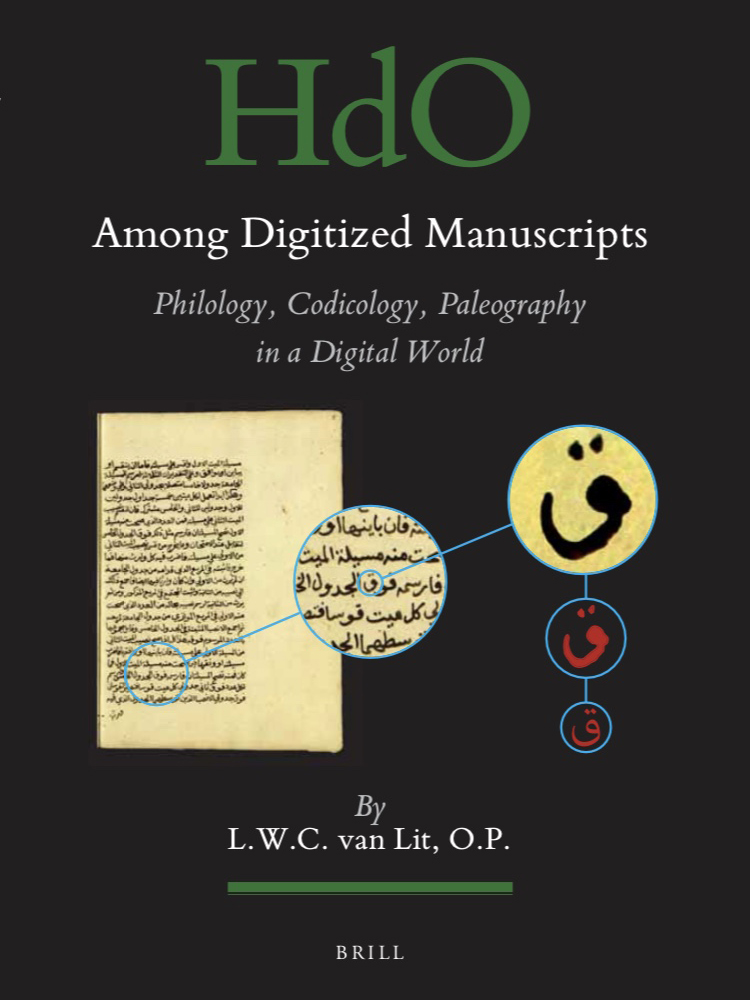

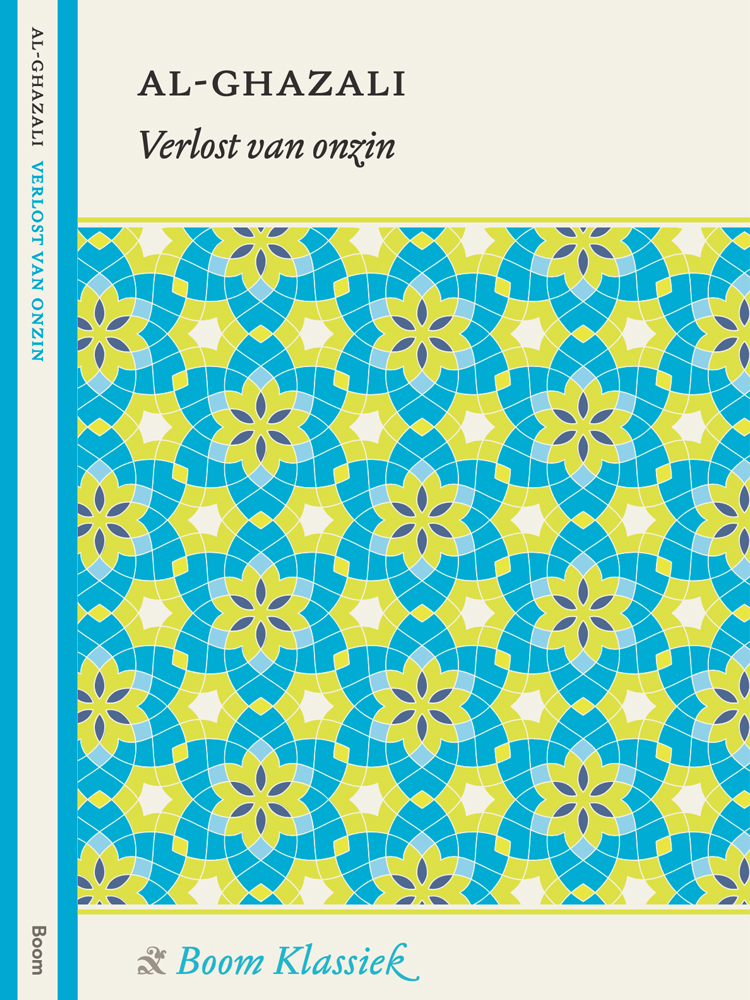

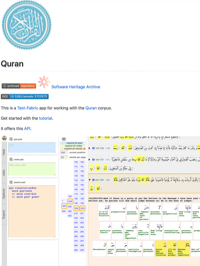
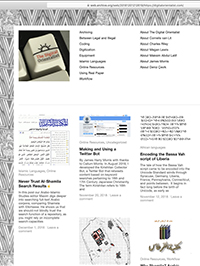
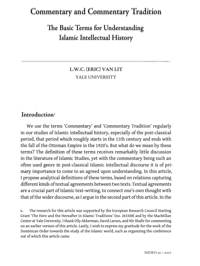
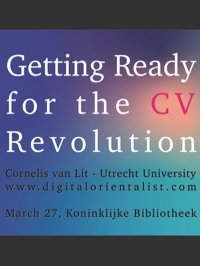

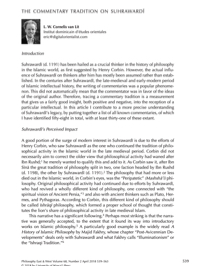
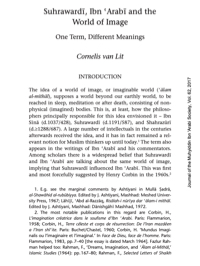
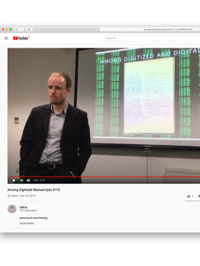
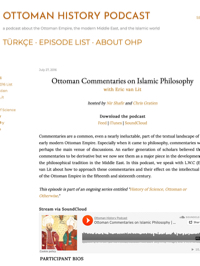
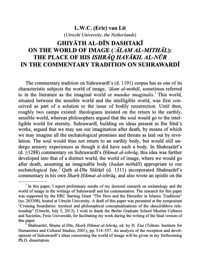

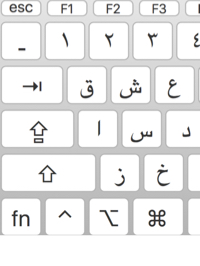
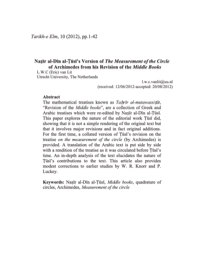


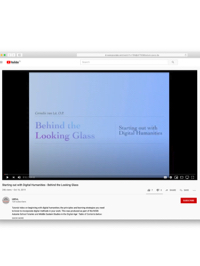
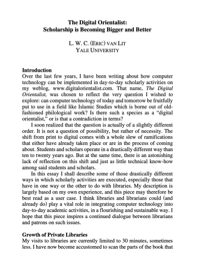


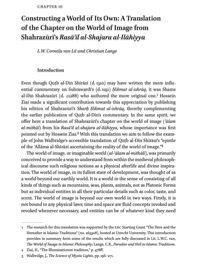

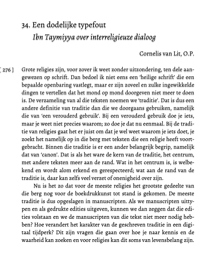
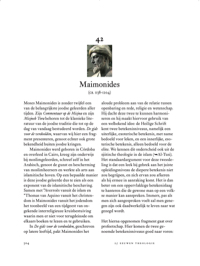
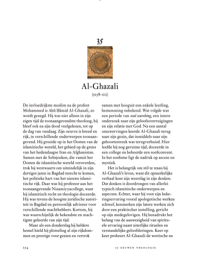

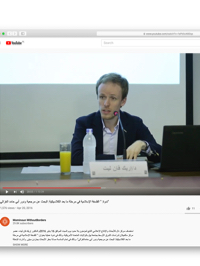

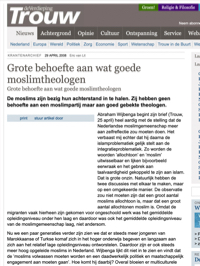
Reconsidering Arabic Roots for the Tertia Via
This paper reopens the debate on the possibility that Aquinas borrowed his tertia via from a Latin translation of Maimonides ‘Guide for the Perplexed’. After introducing the text of the tertia via, I shall analyze the first part and conclude that while a ‘metaphysical’, tenseless reading is correct, we should not be nervous to call Aquinas’s reasoning for what it is: flawed. Framing the problematic passage in its historical context, I shall then argue that the flaw lies not so much with Aquinas, but with the source he was borrowing from. This is Maimonides’ Dalālat al-ḥāʾirīn (“The Guide for the Perplexed”), and in fact more specifically the blame is to be given to an early translator into Latin.